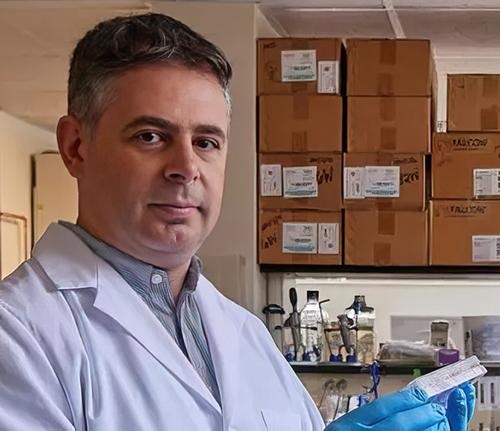Technologies Currently Used in Clinical Practice
Technologies Currently Used in Clinical Practice
Scientists Revive and Characterize 13 Ancient “Zombie” Viruses Isolated from Siberian Permafrost
Viruses are between 27,000 to 48,500 years old and not dangerous, but researchers say thawing permafrost may one day release pathogens capable of infecting humans
Last fall, European researchers working with virologists and genetic scientists at the Aix-Marseille University in France reported having revived and characterized 13 previously unknown “zombie” viruses isolated from Siberian permafrost samples, including one that was almost 50,000 years old. This will be of particular interest to microbiologists and clinical laboratory managers since these organisms are new to science and may be precursors to infectious agents active in the world today.
The work of the European scientists demonstrates how advancements in genome sequencing and analysis of DNA data are becoming, faster, less expensive, and more precise. That’s good because the researchers warned that, should the permafrost continue to thaw, other previously dormant viruses could be released, posing potential risks for public health.
The scientists published their findings in the open-access journal Viruses titled, “An Update on Eukaryotic Viruses Revived from Ancient Permafrost.”
The pathogens isolated by the researchers are so-called “giant viruses” that infect Acanthamoeba, a commonly found genus of amoeba, and thus are not likely to pose an immediate health threat, the researchers wrote.
However, the scientists expressed concern. “We believe our results with Acanthamoeba-infecting viruses can be extrapolated to many other DNA viruses capable of infecting humans or animals. It is thus likely that ancient permafrost … will release these unknown viruses upon thawing,” they stated in their Viruses paper.
It’s unknown how long the viruses “could be infectious once exposed to outdoor conditions (UV light, oxygen, heat), and how likely they will be to encounter and infect a suitable host in the interval,” they added. However, “the risk is bound to increase in the context of global warming, in which permafrost thawing will keep accelerating, and more people will populate the Arctic in the wake of industrial ventures.”

“In nature we have a big natural freezer, which is the Siberian permafrost,” virologist Paulo Verardi, PhD (above), head of the Department of Pathobiology and Veterinary Science at the University of Connecticut, told The Washington Post. “And that can be a little bit concerning.” However, “if you do the risk assessment, this is very low. We have many more things to worry about right now.” Nevertheless, clinical laboratories may want to remain vigilant. (Photo copyright: University of Connecticut.)
Extremely Old, Very Large Viruses
The newly discovered viruses were found in seven different permafrost samples. Radiocarbon dating determined that they had been dormant for 27,000 to 48,500 years. But viruses contained in permafrost could be even older, the researchers wrote, as the time limit is “solely dictated by the validity range of radiocarbon dating.”
In their Viruses paper, the researchers noted that most of the 13 viruses are “at a preliminary stage of characterization,” and others have been isolated in the research laboratory “but not yet published, pending their complete genome assembly, annotation, or detailed analysis.”
“Every time we look, we will find a virus,” study co-author Jean-Michel Claverie, PhD, told The Washington Post. “It’s a done deal. We know that every time we’re going to look for viruses—infectious viruses in permafrost—we are going to find some.”
Claverie is a professor emeritus of genomics and bioinformatics in the School of Medicine at Aix-Marseille Université in Marseille, France. He leads a university laboratory known for its work in “paleovirology,” and in 2003, discovered the first known giant virus, dubbed Mimivirus. The research team included scientists from Germany and Russia.
According to CNN, unlike regular viruses that generally require an electron microscope to be viewed, giant viruses can be seen under a standard light (optical) microscope. Claverie’s laboratory previously isolated giant viruses from permafrost in 2014 and 2015.
Protecting Against Accidental Infection
To demonstrate the infectious potential of the viruses, the researchers inserted the microbes into cultured amoeba cells, which the researchers describes as “virus bait,” The Washington Post reported. One advantage of using Acanthamoeba cultures is to maintain “biological security,” the researchers wrote in their paper.
“We are using [the amoeba’s] billion years of evolutionary distance with human and other mammals as the best possible protection against an accidental infection of laboratory workers or the spread of a dreadful virus once infecting Pleistocene mammals to their contemporary relatives,” the paper noted. “The biohazard associated with reviving prehistorical amoeba-infecting viruses is thus totally negligible compared to the search for ‘paleoviruses’ directly from permafrost-preserved remains of mammoths, woolly rhinoceros, or prehistoric horses.”
The paper cites earlier research noting the presence of bacteria in ancient permafrost samples, “a significant proportion of which are thought to be alive.” These include relatives of contemporary pathogens such as:
How Dangerous are Ancient Viruses?
“We can reasonably hope that an epidemic caused by a revived prehistoric pathogenic bacterium could be quickly controlled by the modern antibiotics at our disposal,” the researchers wrote, but “the situation would be much more disastrous in the case of plant, animal, or human diseases caused by the revival of an ancient unknown virus.”
However, according to The Washington Post, “Virologists who were not involved in the research said the specter of future pandemics being unleashed from the Siberian steppe ranks low on the list of current public health threats. Most new—or ancient—viruses are not dangerous, and the ones that survive the deep freeze for thousands of years tend not to be in the category of coronaviruses and other highly infectious viruses that lead to pandemics.”
Cornell University virologist Colin Parrish, PhD, President of the American Society for Virology, told The Washington Post that an ancient virus “seems like a low risk compared to the large numbers of viruses that are circulating among vertebrates around the world, and that have proven to be real threats in the past, and where similar events could happen in the future, as we still lack a framework for recognizing those ahead of time.”
Anthony Fauci, MD, former Director of the National Institute of Allergy and Infectious Diseases (NIAID), responded to an earlier study from Claverie’s lab by outlining all the unlikely events that would have to transpire for one of these viruses to cause a pandemic. “The permafrost virus must be able to infect humans, it must then [cause disease], and it must be able to spread efficiently from human to human,” he told The Washington Post in 2015. “This can happen, but it is very unlikely.”
Thus, clinical laboratories probably won’t see new diagnostic testing to identify ancient viruses anytime soon. But it’s always best to remain vigilant.
—Stephen Beale
Related Information:
Scientists Have Revived a ‘Zombie’ Virus That Spent 48,500 Years Frozen in Permafrost
‘Zombie’ Viruses Are Thawing in Melting Permafrost Because of Climate Change
Ancient Dormant Viruses Found in Permafrost, Once Revived, Can Infect Amoeba
Scientists Revive 48,500-Year-Old ‘Zombie Virus’ Buried in Ice
Scientists Revived Ancient ‘Zombie Viruses’ Frozen for Eons in Siberia
Scientists Warn Long-Frozen ‘Zombie Virus’ Is ‘Public Health Threat’ Amid Thaw
Stanford Medicine Scientists Sequence Patient’s Whole Genome in Just Five Hours Using Nanopore Genome Sequencing, AI, and Cloud Computing
And in less than eight hours, they had diagnosed a child with a rare genetic disorder, results that would take clinical laboratory testing weeks to return, demonstrating the clinical value of the genomic process
In another major genetic sequencing advancement, scientists at Stanford University School of Medicine have developed a method for rapid sequencing of patients’ whole human genome in as little as five hours. And the researchers used their breakthrough to diagnose rare genetic diseases in under eight hours, according to a Stanford Medicine news release. Their new “ultra-rapid genome sequencing approach” could lead to significantly faster diagnostics and improved clinical laboratory treatments for cancer and other diseases.
The Stanford Medicine researchers used nanopore sequencing and artificial intelligence (AI) technologies in a “mega-sequencing approach” that has redefined “rapid” for genetic diagnostics. The sequence for one study participant—completed in just five hours and two minutes—set the first Guinness World Record for the fastest DNA sequencing to date, the news release states.
The Stanford scientists described their new method for rapid diagnosis of genetic diseases in the New England Journal of Medicine (NEJM) titled, “Ultrarapid Nanopore Genome Sequencing in a Critical Care Setting.”

“A few weeks is what most clinicians call ‘rapid’ when it comes to sequencing a patient’s genome and returning results,” said cardiovascular disease specialist Euan Ashley, MD, PhD (above), professor of medicine, genetics, and biomedical data science, at Stanford University in the news release. “The right people suddenly came together to achieve something amazing. We really felt like we were approaching a new frontier.” Their results could lead to faster diagnostics and clinical laboratory treatments. (Photo copyright: Stanford Medicine.)
.
Need for Fast Genetic Diagnosis
In their NEJM paper, the Stanford scientists argue that rapid genetic diagnosis is key to clinical management, improved prognosis, and critical care cost savings.
“Although most critical care decisions must be made in hours, traditional testing requires weeks and rapid testing requires days. We have found that nanopore genome sequencing can accurately and rapidly provide genetic diagnoses,” the authors wrote.
To complete their study, the researchers sequenced the genomes of 12 patients from two hospitals in Stanford, Calif. They used nanopore genome sequencing, cloud computing-based bioinformatics, and a “custom variant prioritization.”
Their findings included:
- Five people received a genetic diagnosis from the sequencing information in about eight hours.
- Diagnostic rate of 42%, about 12% higher than the average rate for diagnosis of genetic disorders (the researchers noted that not all conditions are genetically based and appropriate for sequencing).
- Five hours and two minutes to sequence a patient’s genome in one case.
- Seven hours and 18 minutes to sequence and diagnose that case.
How the Nanopore Process Works
To advance sequencing speed, the researchers used equipment by Oxford Nanopore Technologies with 48 sequencing units called “flow cells”—enough to sequence a person’s whole genome at one time.
The Oxford Nanopore PromethION Flow Cell generates more than 100 gigabases of data per hour, AI Time Journal reported. The team used a cloud-based storage system to enable computational power for real-time analysis of the data. AI algorithms scanned the genetic code for errors and compared the patients’ gene variants to variants associated with diseases found in research data, Stanford explained.
According to an NVIDIA blog post, “The researchers accelerated both base calling and variant calling using NVIDIA GPUs on Google Cloud. Variant calling, the process of identifying the millions of variants in a genome, was also sped up with NVIDIA Clara Parabricks, a computational genomics application framework.”
Rapid Genetic Test Produces Clinical Benefits
“Together with our collaborators and some of the world’s leaders in genomics, we were able to develop a rapid sequencing analysis workflow that has already shown tangible clinical benefits,” said Mehrzad Samadi, PhD, NVIDIA Senior Engineering Manager and co-author of the NEJM paper, in the blog post. “These are the kinds of high-impact problems we live to solve.”
In their paper, the Stanford researchers described their use of the rapid genetic test to diagnose and treat an infant who was experiencing epileptic seizures on arrival to Stanford’s pediatric emergency department. In just eight hours, their diagnostic test found that the infant’s convulsions were attributed to a mutation in the gene CSNK2B, “a variant and gene known to cause a neurodevelopmental disorder with early-onset epilepsy,” the researchers wrote.
“By accelerating every step of this process—from collecting a blood sample to sequencing the whole genome to identifying variants linked to diseases—[the Stanford] research team took just hours to find a pathogenic variant and make a definitive diagnosis in a three-month-old infant with a rare seizure-causing genetic disorder. A traditional gene panel analysis ordered at the same time took two weeks to return results,” AI Time Journal reported.
New Benchmarks
The Stanford research team wants to cut the sequencing time in half. But for now, the five-hour rapid whole genome sequence can be considered by clinical laboratory leaders, pathologists, and research scientists a new benchmark in genetic sequencing for diagnostic purposes.
Stories like Stanford’s rapid diagnosis of the three-month old patient with epileptic seizures, point to the ultimate value of advances in genomic sequencing technologies.
—Donna Marie Pocius
Related Information:
Fastest DNA Sequencing Technique Helps Undiagnosed Patients Find Answers in Mere Hours
Ultrarapid Nanopore Genome Sequencing in a Critical Care Setting
Stanford Researchers Use AI to Sequence and Analyze DNA in Five Hours
UK Researchers Discover Previously Unknown ‘Highly Virulent’ HIV Variant Circulating in Netherlands since 1990s
Though the variant poses low risk thanks to modern HIV treatments, the scientists stress the importance of access to early clinical laboratory testing for at-risk individuals
With the global healthcare industry hyper focused on arrival of the next SARS-CoV-2 variant, pathologists and clinical laboratories may be relieved to learn that—though researchers in the Netherlands discovered a previously unknown “highly virulent” strain of HIV—the lead scientist of the study says there’s “no cause for alarm.”
In a news release, researchers at the University of Oxford Big Data Institute said the HIV variant got started in the Netherlands in the 1990s, spread quickly into the 2000s, and that prior to treatment, people with the new virulent subtype B (VB variant) had exceptionally high viral loads compared to people with other HIV variants.
Fortunately, the scientist also found that around 2010, thanks to antiretroviral drug therapy, the severe variant began to decline.
The scientists published their findings in the peer-reviewed journal Science, titled, “A Highly Virulent Variant of HIV-1 Circulating in the Netherlands.”
‘Nobody Should Be Alarmed’
In an interview with NPR, Chris Wymant, PhD, the study’s lead author, said, “People with this variant have a viral load that is three to four times higher than usual for those with HIV. This characteristic means the virus progresses into serious illness twice as fast, and also makes it more contagious.”
Fortunately, he added, “Existing medications work very well to treat even very virulent variants like this one, cutting down on transmission and reducing the chance of developing severe illness.
“Nobody should be alarmed,” he continued. “It responds exactly as well to treatment as HIV normally does. There’s no need to develop special treatments for this variant.”
Wymant is senior researcher in statistical genetics and pathogen dynamics at the Big Data Institute (BDI).

Genetic Sequences of the Virulent Virus
About 680,000 people worldwide died from AIDS in 2020, down from 1.3 million in 2010, according to US Health and Human Services HIV data.
In their published study, the BDI researchers reported that their analysis of genetic sequences of the VB variant suggested it “arose in the 1990s from de novo (of new) mutation, not recombination, with increased transmissibility and an unfamiliar molecular mechanism of virulence.
“By the time, they were diagnosed, these individuals were vulnerable to developing AIDS within two to three years. The virus lineage, which has apparently arisen de novo since around the millennium, shows extensive change across the genome affecting almost 300 amino acids, which makes it hard to discern the mechanism for elevated virulence,” the researchers noted.
The researchers analyzed a data set from the project BEEHIVE (Bridging the Epidemiology and Evolution of HIV in Europe and Uganda). They found 15 of 17 people positive for the VB variant residing in the Netherlands. That prompted them to focus on a cohort of more than 6,700 Dutch HIV positive people in the ATHENA (AIDS Therapy Evaluation in the Netherlands) cohort database, where they found 92 more individuals with the VB variant, bringing the total to 109.
According to a Medscape report on the study’s findings, people with the VB variant showed the following characteristics:
- Double the rate of CD4-positive T-cell declines (indicator of immune system damage by HIV), compared to others with subtype-B strains.
- Increased risk of infecting others with the virus based on transmissibility associated with variant branching.
Wymant says access to clinical laboratory testing is key to curtailing the number of people who contract the VB variant. “Getting people tested as soon as possible, getting them onto treatment as soon as possible, has helped reduce the numbers of this variant even though we didn’t know that it existed,” he told NPR.
The University of Oxford Big Data Institute study is another example of how constantly improving genome sequencing technology allows scientists to dig deeper into genetic material for insights that can advance the understanding of many diseases and health conditions.
—Donna Marie Pocius
Related Information:
New Highly Virulent and Damaging HIV Variant Discovered in the Netherlands
Highly Virulent Variant of HIV-1 Circulating in the Netherlands
Discovery of HIV Variant Shows Virus Can Evolve to Be More Severe and Contagious



